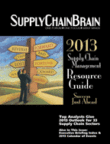
Visit Our Sponsors |
|
|
|
|
|
|
|
|
|
|
|
|
|
|
|
|
|
|
|
|
|
|
|
|
|
|
|
|
|
|
|
|
|
|
|
|
|
|

Across various industries, there is awareness that pricing and commercial terms should better reflect the fact that some customers cost more to serve than others. To address these challenges, companies are increasingly focused on managing total delivered cost (TDC).
TDC comprises aggregate cost associated with raw material sourcing (total landed cost), conversion of materials into finished goods (conversion cost), and delivery of finished goods to customers at agreed-upon service levels and commercial terms (cost to serve). Measuring and managing TDC can be a herculean effort, so companies are breaking down the problem into bite-size pieces, addressing the above cost segments independently. Granular enterprise data and analytical tools are increasingly available to help companies manage TDC as a continuous business process. Important TDC capabilities include network optimization, cost to serve and global trade effectiveness.
Network optimization: This leverages modeling and optimization technology to minimize total supply chain network cost subject to service and operational constraints. Network optimization is evolving beyond a project-based approach to identify optimal DC locations. In mature markets, network optimization is supporting decisions regarding nearshore or onshore options for sourcing to reduce total landed cost. Progressive companies are using network optimization as part of contingency planning to manage potential supply disruptions in a cost-effective manner. Companies are also using network optimization to support supply chain segmentation so that each supply chain is appropriately aligned with cost and service objectives.
Cost to serve: C2S refers to analytics that focus on cost-effectiveness of finished goods delivery to customers. Whereas activity-based costing relates to budgeting and financial management, C2S leverages detailed supply chain data to drive operational efficiency across the order-to-cash process. C2S is concerned with customer ordering behavior, which can significantly impact logistics costs. C2S analysis helps ensure that commercial terms promote supply-chain efficiency on the part of both trading partners. Companies are using C2S analysis to understand the profit contribution of customer segments and product lines to drive pricing and operational policies that increase total profit.
Global trade effectiveness: This is designed to assist multinational companies with enhancing their procurement, import/export and supply chain decision making, while maintaining regulatory compliance. To better understand true delivered cost, companies can evaluate their material and finished goods sourcing options by plant within a given market, to look for available duty and trade reliefs. This approach enables more agile sourcing and supports both strategic and tactical production planning decisions. Although many global trade packages today handle trade compliance very well, the systemic ability to evaluate scenarios and consider the various customs duty and international trade levers remains limited to proprietary applications.
The Outlook
For 2013, expect to see continued interest in total delivered cost. ERP and supply-chain software vendors already support some elements of TDC analysis through total-landed cost modules and optimization packages; expect to see more offerings and functionality in 2013. Offerings will also improve at capturing and analyzing large volumes of data required for these analyses. Economic trends - including fuel, global trade regulations, commodity price volatility - will also play a role in driving the need for TDC capabilities.
##
Ryan Godsil and Tony Ross are Senior Managers in Ernst & Young's Supply Chain Advisory practice and lead the Total Delivered Cost service offering
Alex Bajorinas is a Senior Manger in Ernst & Young's Supply Chain Advisory practice and leads the Global Trade Optimization service offering
Jim Morton is a Senior Manager in Ernst & Young's Supply Chain Advisory practice and leads the Network Design service offering
Ernst & Young refers to the global organization of member firms of Ernst & Young Global Limited, each of which is a separate legal entity. Ernst & Young Global Limited, a UK company limited by guarantee, does not provide services to clients. The views expressed herein are those of the author and do not necessarily reflect the views of Ernst & Young LLP, which is a client-serving member firm of Ernst & Young Global Limited operating in the US.
Keywords: supply chain management, logistics services, logistics & supply chain, logistics management, cost-to-serve analytics, cost to deliver services to customers
RELATED CONTENT
RELATED VIDEOS
Timely, incisive articles delivered directly to your inbox.






